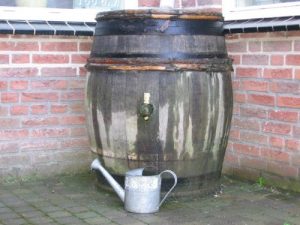Water Conservation
Rainwater harvesting can save the you money and help mother nature at the same time.
Rainwater harvesting can save the you money and help mother nature at the same time.
Eco-conscious living is no longer just a trend; it’s a necessity. With increasing pollution levels, threatening fossil fuels usage, and a larger global carbon footprint than ever before, more homeowners are doing their part to make the world a better place. At Modernize, they value these efforts, but they know it can be overwhelming to find a place to start. But rainwater harvesting is a great step toward a greener home—and it’s something you can do in your very own backyard, even if you don’t have any “green living” experience to speak of. Here’s how to get started.
 Let’s start with the basics; what is rainwater harvesting? It’s the collection of rainwater on site, rather than letting it run off into the earth. There are many reasons homeowners and businesses would want to do this: it creates an independent water supply, it helps mitigate flooding, and it conserves water.
Let’s start with the basics; what is rainwater harvesting? It’s the collection of rainwater on site, rather than letting it run off into the earth. There are many reasons homeowners and businesses would want to do this: it creates an independent water supply, it helps mitigate flooding, and it conserves water.
It sounds complicated, but a rainwater harvester is fairly simple. It channels rainwater from the surface of the home into a series of gutters and pipes. The water flows into the storage tank, which can be above or below ground. You’ll want to keep it covered to avoid mosquitos and contamination. This pure drinking water is safe, and it tastes great, too!
There are numerous environmental benefits to harvesting rainwater, but water conservation is the most impactful. Rainwater is free, and though you may not be able to predict the weather, you can count on the fact that it won’t stop raining entirely. Using this free resource leaves more purified drinking water for the community, and reduces the strain on community water supply facilities, like wells and pipes.
When it comes to inclement weather and natural disasters, rainwater harvesting can save your life. These devices help control flooding by diverting water from gutters and streets. Imagine if you could do a small part to prevent the damage to your home and community, and keep your family healthy at the same time. You can!
In case of a natural disaster, your water supply could become damaged, poisoned, or compromised by foreign objects and chemicals. But by installing a rainwater harvester, you can rest easily, knowing that your family will always have a purified water reservoir for safe drinking.
Dreading opening your mailbox to find another high utility bill? Conserving water means conserving funds. Rainwater harvesting is great for creating clean drinking water, but you can also use that water for other functions—like bathing, using the bathroom, watering plants, and cleaning. Think about how much money you could save if you utilized this free source of water, and you won’t deplete nearby water sources. Bonus benefit: rainwater harvesting also helps to alleviate soil erosion, which makes soil richer and more fertile. It sounds like the perfect time to plant that organic vegetable garden.
Reducing usage of community-wide water sources like dams, pipes, and treatment plants alleviates the deterioration of these facilities paid for with tax money. So, not only could incorporating rainwater usage into your home life help your family’s finances, it could boost the community’s economic health as well. In fact, some community councils offer cash-back rebates for families who install rainwater tanks. We can almost hear that cha-ching!
As if environmental and economic benefits weren’t enough, switching to rainwater harvesting will also improve your family’s health. Pure, fresh drinking water without chemicals is the purest form of hydration, and it tastes great, too! Proper hydration is essential for brain function, exercise, productivity, and fighting disease. If you’re tired of sipping poor-tasting tap water with an odor, you’ll be utterly refreshed by this rainwater alternative.
Rainwater harvesting allows you to stay in control of your family’s health and finances, and it reduces your carbon footprint, too. It may seem complicated at first, but when you discover all of the ways this water conservation method can help you and your community, it’s pretty simple after all.